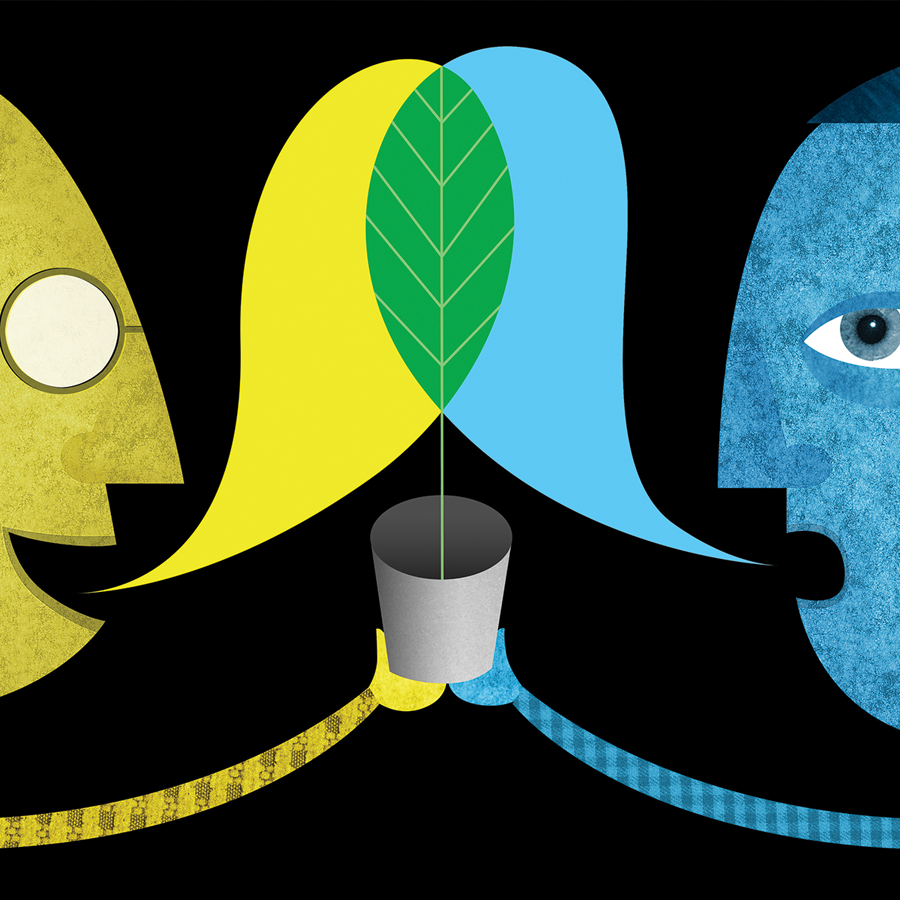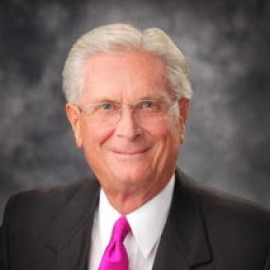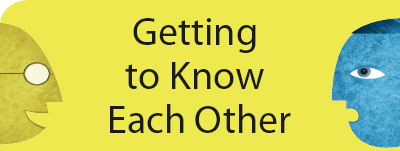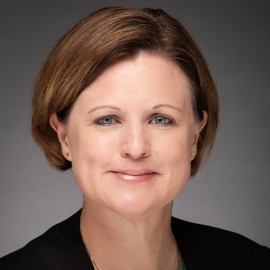
It Takes Two
Credit: JOYCE HESSELBERTH
Fundraising can be distilled into one word: relationships. Relationships with faculty. Relationships with staff. Relationships with alumni. Relationships with the community. And perhaps the most important relationship for a fundraiser—a donor.
The most carefully cultivated, authentic relationships can lead to major and principal gifts, gifts that benefit students in ways that reverberate for generations. Strong relationships based on aligning a donor’s needs, interests, and concerns with meaningful impact inspire donors to become advocates for your institution. These are donors who are part of your community, who attend athletic events and performances, who encourage others to give, who send their children to your institution, who become spokespersons for your initiatives, and who believe in your institution’s mission.
Such meaningful relationships are crucial in resource development efforts for higher education institutions—arguably now more than ever. Philanthropy has shaped U.S. higher education since the founding of the country’s earliest colleges and universities and served as an added source of flexible revenue. Today, though, colleges and universities are increasingly relying on institutional advancement to address budget shortfalls, declining enrollment, and increased needs for resources.
Gifts at the principal and major levels can almost always be attributed to long-standing relationships with the university or a particular cause or interest. For instance, the largest philanthropic gift bestowed to date in 2024, and one of the largest gifts ever to a medical school, made headlines in March. A $1 billion gift from Ruth Gottesman to the Albert Einstein College of Medicine in New York, U.S., will ensure free tuition to all students. Gottesman is a former professor and current board chair who has been deeply involved with the institution for many years.
In donor and institution relationships, it’s vital that donors see not only the impact of their monetary investment but also, and perhaps more important, the value of their advocacy for the institution. To support donors as advocates, development staff members have to understand donors’ motivations and expectations.
We’ve seen that firsthand through our partnership at Utah Valley University, U.S.—Alan as a philanthropist and Christie as an advancement leader. We came together as co-authors to offer our perspectives on the donor-fundraiser relationship, which we believe can and should be meaningful, authentic, and rewarding for both parties.

"Understanding the motivational "whys" behind donor contributions is highly valuable information for university leadership."
The Donor’s Perspective
Alan Hall is a philanthropist, founder of several successful financial and technology companies, and former board member of the Utah Board of Higher Education. He and his wife, Jeanne, run the Alan and Jeanne Hall Foundation.
As a donor, advocate, and former university trustee chairman, I am pleased to share my thoughts on the multifaceted motivations that drive donors to contribute to universities. I also wish to recommend how fundraisers should interact and communicate with some of their most important financial supporters.
For many years, my wife and I have passionately dedicated ourselves to supporting various nonprofit organizations in Utah through our time, skills, and financial resources. Our involvement has been multifaceted, ranging from leadership roles on boards of trustees and advisory committees to spearheading fundraising efforts and serving as lead donors. In certain instances, we’ve committed substantial financial support to catalyze the development and execution of innovative initiatives. Additionally, we’ve championed public grants and legislative funding, and have advocated for institutional leaders to prioritize student and family needs. Throughout these endeavors, we’ve consistently communicated our perspectives with empathy and humility, mindful of fostering constructive dialogue and collaboration.
Donor contributions play a pivotal role in the sustainability and growth of universities in the United States. Understanding the motivational “whys” behind donor contributions is highly valuable information for university leadership. Knowing the background, interests, and wishes of potential financial supporters can lead to building and maintaining fruitful relationships with them.

Try these questions from Christie and Alan to get to know a donor.
- If you could return to school and take one class, what would it be and why?
- How do you envision the impact of your gift?
- What excites you about the institution right now?
- How would you like to engage with the institution beyond your gift?
- Can you share the story of someone who impacted your own educational journey?
- What brings you joy and happiness?
What motivates donors to give? Many donors contribute to universities as a way of expressing gratitude for the education they received or the positive experiences they had during their time as students. Alumni, in particular, often feel a strong sense of loyalty to their alma maters and seek to give back to the institutions that helped shape their lives.
Some of the donors I know well are motivated by a desire to make a positive impact on society through their philanthropic activities. They see supporting higher education as a means of investing in the future by empowering individuals with the knowledge and skills they will need to address societal challenges and opportunities.
Being a venture capitalist and a successful entrepreneur, I see many of my peers, especially corporate executives and high-net-worth individuals, contribute to universities to enhance their public image and reputation. Endowing a professorship or funding a research center can provide them with the visibility and prestige they seek, within both academia and the broader community.
And finally, I have friends who are donors who view their contributions as opportunities to strengthen their ties with fellow alumni and expand their professional networks. They are eager to attend university fundraising events and donor recognition programs, which can provide them with opportunities to network with other university supporters.
Now, as donors, we expect various forms of recognition, stewardship, and impact reporting from the institutions we support. While our motivations for giving vary, there are several common expectations that we have for our philanthropic investments. Donors often expect acknowledgment and recognition for their contributions, ranging from public acknowledgment in donor honor rolls; plaques; or naming opportunities for facilities, programs, or endowed chairs. This form of gratitude and validation of their support enhances their sense of pride and affiliation with the institution. On the other hand, some donors, for varying reasons, would rather avoid public recognition. In cultivating a relationship, take the time to understand each individual’s desire for and comfort with different forms of recognition.
Donors expect effective stewardship regarding their contributions, including transparency and accountability of funds, regular updates on the use and impact of their donations, and opportunities for meaningful engagement with the institution. Stewardship efforts demonstrate the institution’s commitment to honoring donor intentions and maximizing the effectiveness of philanthropic investments.
Donors seek tangible and impactful outcomes from their contributions, such as advancements in research, scholarship opportunities for students, infrastructure improvements, or community outreach initiatives. We expect the institution to demonstrate the transformative power of our donations, showcasing how our support directly contributes to the institution’s mission and goals. Many of us derive personal fulfillment and satisfaction from our philanthropic investments, knowing that our contributions are making a positive difference in the lives of others contributing to the greater good. We expect institutional leadership to recognize and celebrate our role in achieving meaningful outcomes, fostering a sense of connection and purpose.
Donors often seek opportunities for ongoing involvement and engagement with the institution beyond financial contributions. We may expect invitations to help with fundraising or to attend special events, networking opportunities with faculty and students, participation in advisory boards or committees, or opportunities to mentor students.
Some donors aspire to leave lasting legacies and have an impact through their philanthropy, shaping the future trajectory of the institution and leaving a positive mark on society. They expect the institution to honor their legacy and preserve their philanthropic vision for future generations, ensuring that their contributions have a lasting and meaningful impact.
Overall, university donors expect a combination of recognition, stewardship, impact, personal fulfillment, involvement, and legacy from the institutions they support. Meeting these expectations requires a strong and sincere relationship with a fundraiser that includes proactive communication, transparent stewardship practices, and meaningful engagement initiatives that demonstrate the value and impact of philanthropic investments. By fulfilling these expectations, institutions cultivate strong relationships with donors, inspire continued support, and advance their mission and goals.
Donors as Ambassadors

Helping donors become advocates for the university is important to the UVU Institutional Advancement Strategic Engagement team. With that in mind, the team launched the EverGREEN Ambassador Program in 2022.
UVU developed the program to support the university’s inaugural comprehensive “EverGREEN” fundraising campaign. Staff launched the ambassador initiative during the quiet phase of the campaign in May 2022 to strategically engage with key donors leading up to the formal public campaign launch in October.
Through the program, UVU invited supporters to serve as extensions of the Strategic Engagement team. The team identified principal-level donors who have more than 10,000 followers on at least one social media platform for influencer marketing campaigns, and tracked engagement among participants and their followers before, during, and after their service as ambassadors.
Each month, the Strategic Engagement team provided EverGREEN Ambassadors with UVU-related updates to share with their followers on selected social media channels. The team provided recommended visuals, captions, and hashtags, as well as a guide for sharing EverGREEN content. In return, ambassadors received “insider” information about the campaign and unique swag and other appreciation gifts.
The team’s goals were to increase strategic engagement with principal and major donors via social media and increase use of the hashtag #EverGREEN among those donors by 25%. The team met and exceeded those goals and received recognition in the form of a gold 2023 CASE Circle of Excellence Award in the Targeted Constituency Engagement category.
The Advancement Professional’s Perspective
Christie Denniston is Associate Vice President of Strategic Engagement for Utah Valley University Institutional Advancement, where she oversees marketing and communication for institutional advancement, data and analysis, executive events, and donor relations. An experienced higher education fundraiser, she has worked at three other educational institutions, where she led several campaigns.
A common misstep many advancement professionals make is immediately engaging with a potential donor without first understanding their needs and interests. That data is the foundation of understanding. But as essential as measurement is, we don’t get to those measurable outcomes without human connection. That connection starts when we take time and exercise thoughtful engagement and sincerity in getting to know our donors, understanding them as people, and learning what motivates them to give. It is important to consider the person as a whole individual—not just as a donor.
I’ve known Alan as a higher education advocate, friend, and now as a principal donor to UVU. Friendship doesn’t always come up when discussing the donor-fundraiser relationship. But friendship can often be the outcome. I’m fortunate to have made many such friendships throughout my career, which has added a layer of job satisfaction to my work that I don’t take for granted.
I was Director of Marketing and Public Relations at another Utah university when I first met Alan in 2013. He was a member of the university’s board of trustees. We got to know each other, first through our commitment to the institution and then through things we had in common, such as a love of the arts. He was a donor to the university, but that did not come into play in our relationship.
Although he supported multiple colleges and universities throughout Utah with major gifts, Alan was not a donor to UVU when I came here in 2020. When we began outreach to him as a prospective donor, I was quite fortunate that I had an established friendship with him. I knew his interests, motivations, and expectations as a donor. It also helped that Alan knew our President, Astrid Tuminez. (A visionary president is one of the most powerful assets a fundraiser can have. Don’t ever underestimate the power of your president in building relationships with donors.)
Alan’s foundation had a program through which $1 million endowments were given to higher education business schools in Utah to support professional sales programs. We were able to show perfect alignment between the impact he sought through that program and UVU initiatives, leading to an endowment for our business school.
Through our stewardship of the gift, we ensured meaningful touch points closely aligned with Alan’s interests, which include inspiring the next generation of entrepreneurs. We invited Alan to the school as part of our lecture series on entrepreneurship. We launched the UVU Alan Hall Marketing and Sales Invitational, a competition for high school students interested in studying business. And because he is a donor who wants to interact with those impacted by his gift, we have invited him to classes to hear business student presentations. Students so often are the “why” for donors, and their experiences are the most authentic, tangible demonstration of impact.
Yes, I was fortunate to have an established friendship with this now principal donor. With other donors, our team starts with a holistic approach to data collection that allows us to understand prospective donors’ needs, interests, concerns, and passions, from their favorite restaurant to a favorite professor to an interest in first-generation students.
That intricate level of data mining allows us to embark on meaningful, authentic engagement—to move beyond sending holiday and birthday cards. Instead, we’ll send a card and special present to celebrate the anniversary of a donor’s first gift or the date of the donor’s graduation from our university. Stewardship means engagement that ensures the individual feels truly connected to the organization and clearly sees how their support makes an impact. When we take the time to cultivate a sincere connection, it never feels generic or transactional.

"When we take the time to cultivate a sincere connection, it never feels generic or transactional."
One of the most important touch points for donors comes in the form of good storytelling, which can fulfill a donor’s desire to see the transformative impact of their gift. We launched a new initiative in 2024, A Year of Student Impact, through which we post a student story every single day (this year 366 stories for leap year!) on our website. Each story speaks to the life-changing impact of philanthropy on students. We are receiving very positive feedback from our community members, including donors, with many telling us they check every day to read the latest story.
Holistic research, meaningful engagement, and demonstrating appreciation based on a donor’s preference can often lead to what I consider the ultimate desired outcome: your donor becoming an advocate for your institution.
Recently, a gift made to UVU’s first-generation initiative by a Utah-based philanthropic leader became just that. After the donor made the principal gift, they highlighted and publicly advocated for the university not just across social media channels but also (more importantly) in their spheres of influence. The result? An additional $3 million given—not because a development director asked but because the donor had become an advocate for the university’s initiatives.
Two Perspectives, One Mission
Fundraisers and donors come together initially with two points of view, but when they cultivate a relationship, they are motivated by a shared vision. Alignment, impact, authenticity, gratitude, touch points, and advocacy: Let these be the guiding words when you consider a new and ongoing relationship with a donor. Amazing outcomes for students can happen when you make a meaningful connection!
About the author(s)
Christie Denniston is Associate Vice President of Strategic Engagement for Utah Valley University Institutional Advancement.
Alan Hall is a philanthropist, entrepreneur, and former board member of the Utah Board of Higher Education.
Tags
Article appears in:

July - August 2024
Creating a Global Network: Dutch alumni teams extend their international reach. Also, meaningful donor and fundraiser relationships, meeting the mission at public regional universities, and connecting the pieces on a community college brand refresh.


